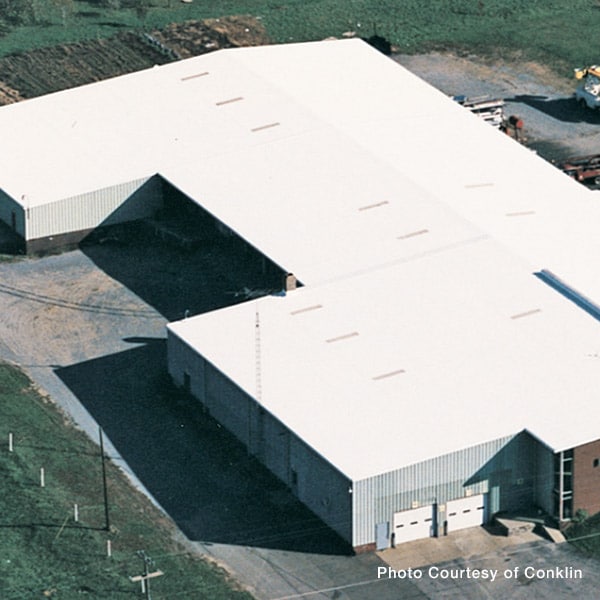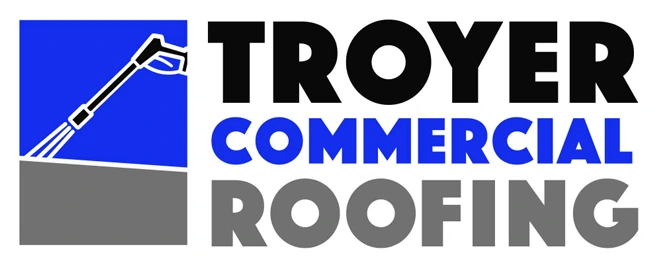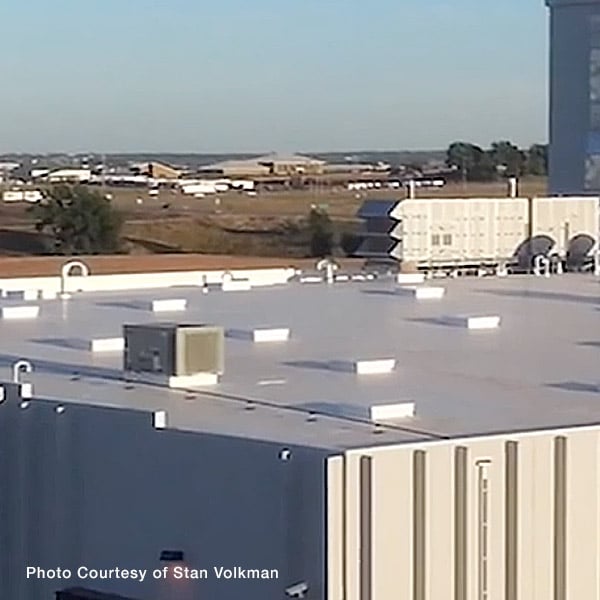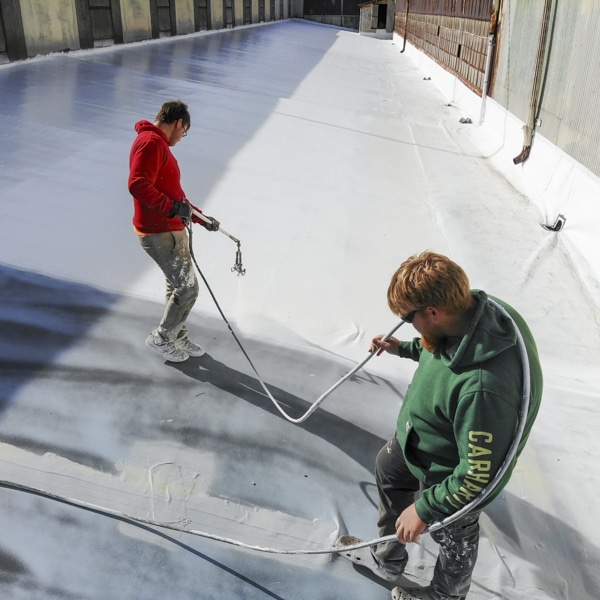Energy-Efficient Roofing for Commercial Premises
Many business owners often don’t realize that a significant reduction in operational costs can be achieved with an energy-efficient roofing system. Most commercial roofing materials like asphalt, modified bitumen, concrete, EPDM, and others absorb much of the sun’s UV rays as heat. For example, studies have shown that when the ambient temperature is 90°F, an asphalt rooftop can reach 180°F. That’s more than hot enough to fry an egg! In addition, the heat from your roof transfers into your building, increasing the load on your HVAC equipment. Not to mention the additional wear and tear on roofing materials caused by the stress of thermal movement. Even reflective materials can be damaged or eventually wear out and lose effectiveness. So, it’s a good idea to ensure your roofing system is as energy efficient as possible with annual commercial roof inspections in Florida.
 Troyer Commercial Roofing is a certified Conklin Commercial Roofing Systems contractor that restores aging and weathered flat or low-slope commercial, industrial, and agricultural roofs in Southwest Florida with a durable, long-lasting, energy-efficient roofing system.
Troyer Commercial Roofing is a certified Conklin Commercial Roofing Systems contractor that restores aging and weathered flat or low-slope commercial, industrial, and agricultural roofs in Southwest Florida with a durable, long-lasting, energy-efficient roofing system.
Superior Solar Reflectivity Equals Higher Energy Efficiency
Conklin’s energy-efficient cool roof coatings reflect over 80% of the sun’s UV radiation rather than absorbing it as heat. This outperforms other reflective materials, including aluminized coating. As a result, Conklin’s energy-efficient roofing systems have a solar rating index (SRI) of 107. In comparison, aluminized coating and asphalt have an SRI of 55 and 3, respectively. The Lawrence Berkely National Laboratory developed the solar rating index (SRI) to measure the effectiveness of a roof’s ability to reflect solar heat. Roofs with a higher SRI reflect more heat and have higher energy efficiency.
Energy-Efficient Roofing Improves Efficiency Roofing Keeps Buildings Cooler
The superior solar reflectivity of our energy-efficient cool roofs substantially lowers rooftop surface temperatures. While an aluminized coating roof’s surface temperature is 160°F in 90°F weather, our cool roof coatings will maintain a surface temperature of about 100°F, much closer to the ambient temperature. The cooler surface temperature reduces the heat transferred in and around your building. In addition, the higher energy efficiency will help keep interior spaces cooler while reducing the load on your HVAC equipment.
Reducing The Heat Island Effect
When roofing materials absorb much of the UV radiation, it not only makes interior spaces warmer but also increases the exterior temperature surrounding your building, exposing the community to more pollution. This phenomenon is the heat island effect. It also weakens roofing materials exposing your facility to more frequent roof leak repairs and premature roof replacement. The superior solar reflectivity of our energy-efficient roofing systems will reduce your roof’s surface temperature by up to 80°F. This will substantially reduce the heat island effect, which will help reduce pollution in your community. Our white reflective coatings also form a durable leak-free waterproof barrier that will extend your roof’s useful life for years without replacement.
Reduce Cooling Costs Up to 30%
According to the U.S. Department of Energy (DOE), HVAC equipment contributes to 40% of commercial energy bills. With Conklin’s highly reflective energy-efficient roofing coatings, your air conditioning system will operate more efficiently, reducing cooling costs by up to 30%. The insulation in our single-ply membrane roofing and spray polyurethane foam (SPF) will keep building interiors warmer in cooler weather resulting in year-round energy savings and reduced operational costs. Our energy-efficient roofing can often pay for itself during the warranty period. In addition, tax credits, utility rebates, and other financial incentives may also be available.
 Energy-Efficient Roofing Systems in Southwest Florida
Energy-Efficient Roofing Systems in Southwest Florida
Troyer Commercial Roofing can transform your existing or aging roof into a long-lasting, highly energy efficient roofing system. This will reduce energy consumption and lower utility costs. For a limited time, we are offering FREE commercial roof inspections in Anna Maria, Bradenton, Fruitville, Sarasota, Osprey, and surrounding communities in Florida. Call our expert contractors to schedule an appointment and free estimate today!
Long-Term Benefits of Energy-Efficient Roofing
Investing in energy-efficient roofing provides long-term financial and environmental benefits. Over time, the reduced energy consumption leads to significant cost savings on utility bills. Additionally, by lowering the amount of heat absorbed, it can help extend the lifespan of the roofing materials, reducing the frequency of repairs or replacements. This contributes to a lower overall environmental impact, as fewer resources are needed for maintenance and new materials. Furthermore, energy-efficient roofs can enhance the value of your commercial property by improving its sustainability profile.
Conklin Roofing Systems and Their Energy Efficiency
Conklin Roofing Systems are designed with advanced technology to maximize energy efficiency. These systems utilize high-performance reflective coatings that meet or exceed industry standards for solar reflectivity and thermal emittance. The Conklin systems are rigorously tested to ensure they provide superior performance in hot climates, such as those in Florida. By opting for Conklin roofing, businesses benefit from a system that not only enhances energy efficiency but also provides robust protection against the elements, thereby delivering long-term value and reliability.
How to Choose the Right Energy-Efficient Roofing System
Selecting the right energy-efficient roofing system involves considering several factors, including the type of building, local climate, and specific energy needs. Consult with a professional roofing contractor to evaluate these factors and recommend the best solution. Factors such as the roof’s current condition, slope, and material compatibility should be assessed. An experienced contractor can guide you through options such as reflective coatings, cool roofing membranes, or insulation enhancements to ensure you achieve the highest level of energy efficiency for your commercial property.
Understanding Energy-Efficient Roof Coatings
Energy-efficient roof coatings are formulated to reflect more sunlight and absorb less heat compared to traditional materials. These coatings can be applied to various roofing surfaces, including metal, asphalt, and single-ply membranes. They work by creating a reflective layer that prevents excessive heat buildup, which helps maintain cooler indoor temperatures and reduces the workload on HVAC systems. By applying energy-efficient coatings, you can significantly enhance the overall energy performance of your roof, contributing to lower energy costs and a more comfortable building environment.
The Role of Roof Insulation in Energy Efficiency
Proper roof insulation plays a crucial role in enhancing energy efficiency. Insulation helps to regulate indoor temperatures by reducing heat transfer between the roof and the building interior. This means that in cooler weather, insulation keeps heat inside, and in warmer weather, it helps to keep the heat out. Combining high-quality insulation with energy-efficient roofing materials amplifies the overall performance of your roofing system, leading to greater energy savings and improved indoor comfort.
FAQs About Energy-Efficient Roofing
What is energy-efficient roofing?
Energy-efficient roofing refers to roofing systems designed to minimize heat absorption and reduce the load on HVAC systems, leading to lower energy consumption. These roofs often feature reflective coatings or materials that reflect sunlight and heat away from the building. By maintaining cooler rooftop temperatures, energy-efficient roofing helps reduce cooling costs and improve overall building comfort. Options include reflective coatings, cool roofs, and high-performance insulation materials.
How does energy-efficient roofing reduce cooling costs?
Energy-efficient roofing reduces cooling costs by reflecting a significant portion of the sun’s heat away from the building. This prevents excessive heat buildup on the roof surface, which can otherwise transfer into the building. Furthermore, it can increase the demand on air conditioning systems. By maintaining lower rooftop temperatures, energy-efficient roofs help keep indoor spaces cooler, leading to reduced energy consumption and lower cooling bills. Some systems can cut cooling costs by up to 30%.
What are the benefits of using energy-efficient roofing materials?
Energy-efficient roofing materials offer several benefits, including lower energy bills, improved indoor comfort, and extended roof lifespan. By reflecting sunlight and reducing heat absorption, these materials help maintain more stable indoor temperatures, reducing the workload on HVAC systems. Additionally, energy-efficient roofs often require less maintenance and can qualify for tax credits and rebates. They also contribute to environmental sustainability by reducing overall energy consumption and lowering greenhouse gas emissions.
How do I know if my roof is energy-efficient?
To determine if your roof is energy-efficient, check its solar reflectance and thermal emittance properties. Solar reflectance measures how well the roof reflects sunlight, while thermal emittance indicates how well it releases absorbed heat. Roofs with high values in these areas are more energy-efficient. Additionally, consider conducting a professional energy audit to assess your roof’s performance. Such commercial roofs will help maintain lower indoor temperatures and reduce cooling costs compared to traditional roofing materials.
What types of roofing materials are considered energy-efficient?
Common energy-efficient roofing materials include reflective coatings, cool roofing membranes, and highly insulating materials. Reflective coatings, such as those made from acrylic or silicone, are applied over existing roofs to reflect sunlight and reduce heat absorption. Cool roofing membranes, like those made from single-ply materials or modified bitumen, are designed to reflect more sunlight and absorb less heat. High-performance insulation materials, such as spray polyurethane foam (SPF), also contribute to overall energy efficiency by reducing heat transfer.
Can energy-efficient roofing be applied to existing roofs?
Yes, energy-efficient roofing solutions can often be applied to existing roofs. For instance, reflective coatings can be added over various types of existing roofing materials to improve their energy efficiency. Additionally, some cool roofing membranes can be installed over existing roofs to enhance performance. It’s important to have a professional roofing contractor assess the current condition of your roof to determine the most appropriate commercial roofing solution and ensure proper installation.
What is the cost of installing an energy-efficient roofing system?
The cost of installing an energy-efficient roofing system varies depending on the type of material, the size of the roof, and the complexity of the installation. Generally, commercial roofs may have a higher upfront cost compared to traditional roofing. However, they offer long-term savings through reduced energy bills and extended roof lifespan. Many energy-efficient roofing options also qualify for tax credits and rebates, which can help offset the initial investment. It’s advisable to get multiple quotes from contractors to compare costs and benefits.
How long does an energy-efficient roof last?
The lifespan of an energy-efficient roof depends on the type of materials used and the quality of installation. High-quality roofing systems, such as those with reflective coatings or durable cool roofing membranes, can last 20 years or more with proper maintenance. Additionally, many roofs are designed to be low-maintenance and durable, which contributes to their long-term performance. Regular inspections and maintenance can further extend the lifespan of your energy-efficient roof.

 Energy-Efficient Roofing Systems in Southwest Florida
Energy-Efficient Roofing Systems in Southwest Florida